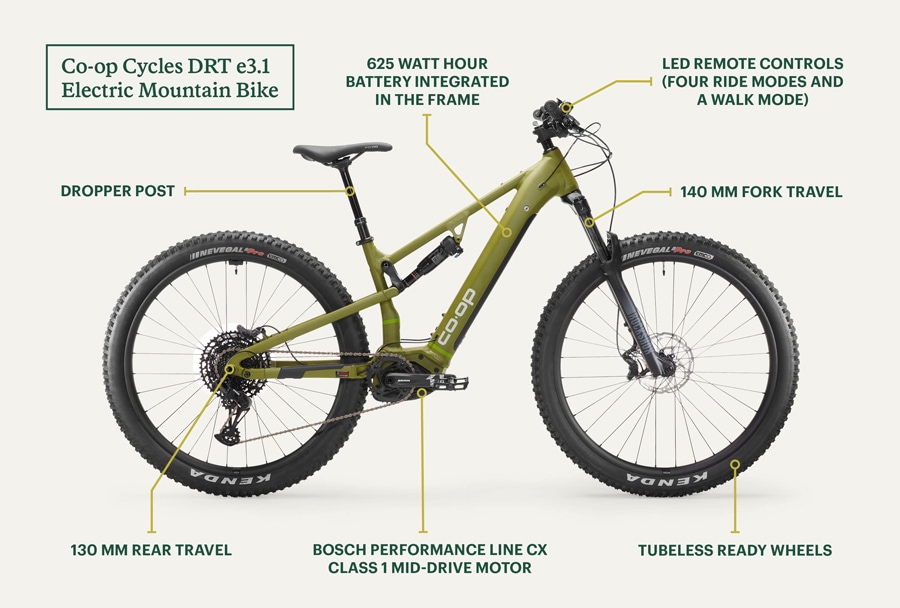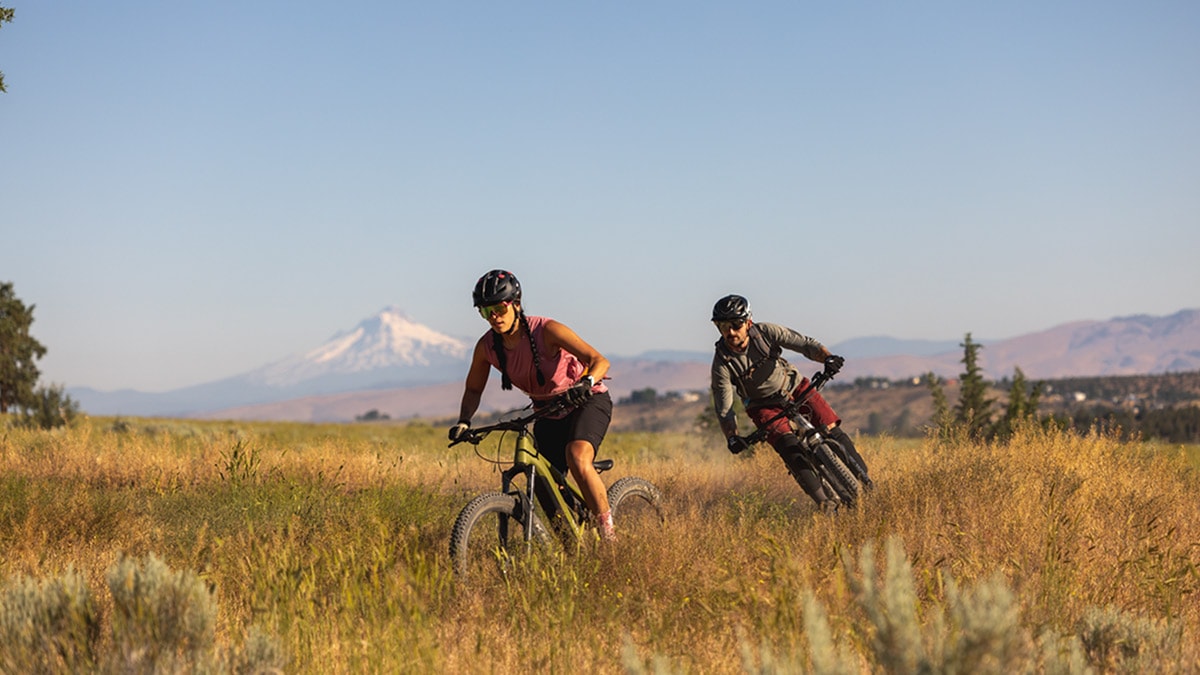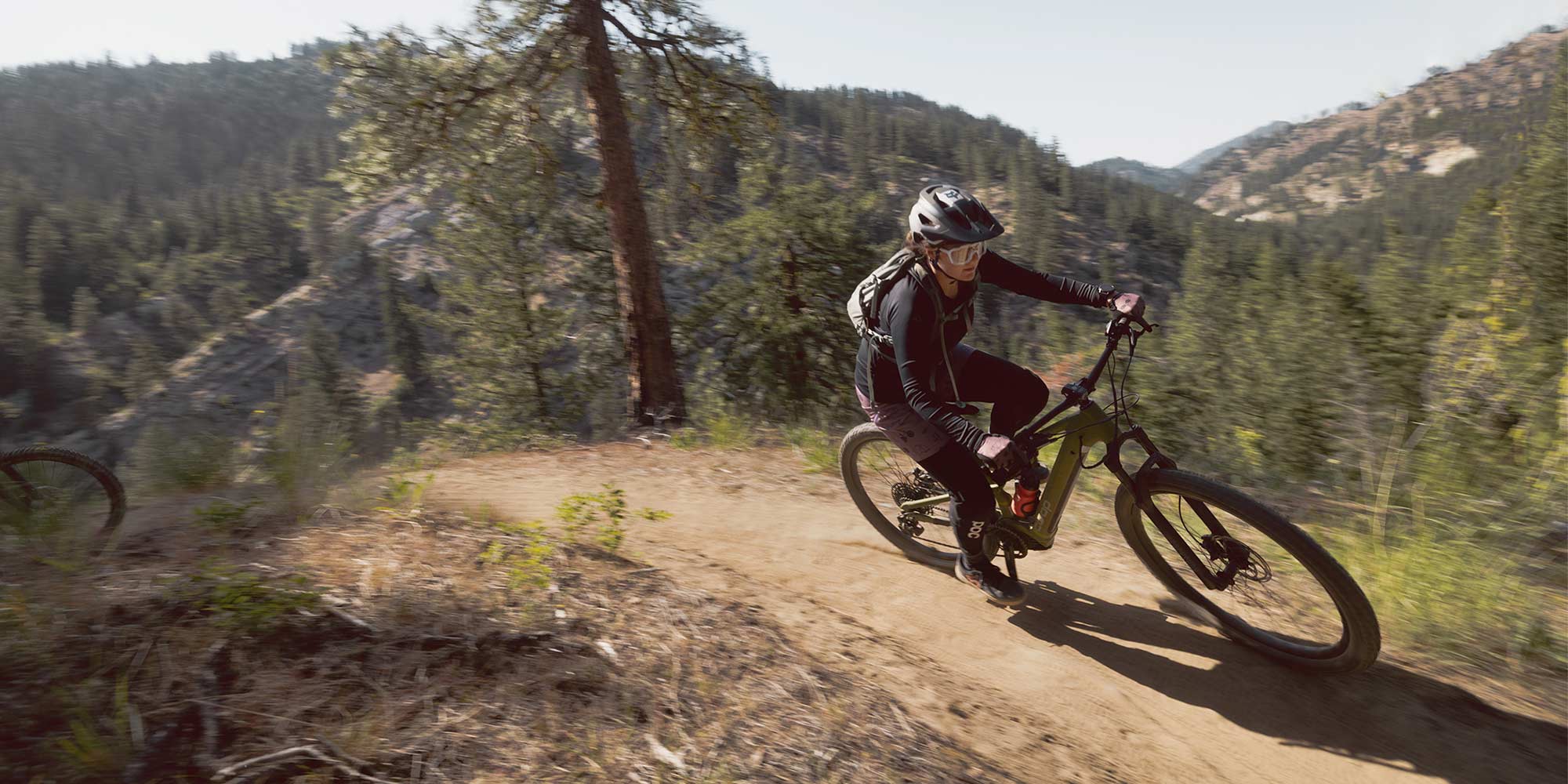What if the uphill was as much fun as the descent?
That’s the hard-to-imagine promise of electric mountain biking. You’re supposed to earn that sweet relief of a downhill send, aren’t you? Suffer, on the punishing climb to the summit? Sweat, swear, gnash the teeth?
No longer. The electric mountain bike (e-MTB) has changed everything about what it means to slide into singletrack. Already popular in Europe, battery-powered cycling is in the midst of a moment in the U.S. If you sneer at e-mountain bikers for “cheating,” it may be because you have yet to experience the childlike joy this new steed offers. It means rumbling over technical stretches and blasting up steep slopes while saving energy in your personal tank to enjoy other parts of the ride. Suddenly a 30-mile, three-hour loop isn’t so daunting.
Designers with REI bike brand, Co-op Cycles, waited for just the right moment to craft the company’s first-ever electric mountain bike, the DRT e3.1, a svelte full-suspension trail bike with a powerful 625-watt-hour Bosch battery and quality SRAM components.
Co-op Cycles has been designing a line of DRT mountain bikes since 2017. “An e-mountain bike is the perfect extension to the line because it allows our members to go further, ride more trails and get out more,” says product manager Heather Henderson. “At the co-op, we know our riders go out for the love of the outdoors, so we build bikes that give them the best experience possible,” she adds.
Behind the Build

Some of the earliest offerings in the e-MTB category have been overweight beasts, powerful but unwieldy. The right blend of components and technology is vital. So, when Co-op Cycles design engineer Andy Aiken and Henderson, both avid cyclists with deep experience in manufacturing bikes, got to work on the brand’s first e-mountain bike, they took the task seriously.
Performance e-mountain bikes can easily become very expensive (up to five figures), but approachability is a co-op core value. Making an e-bike both affordable and competitive was no small feat, however. “You don’t just take a regular bike and slap a motor on it,” Henderson says. “This is its own unique thing.”
Among the most important decisions was to team up with industry leader Bosch eBike Systems for the project’s power, Aiken says. Bosch has been making e-bike motors and batteries since 2009, and its systems—which include the computer, drive unit and battery—are designed to work as part of a seamless ecosystem. Parts are also widely available and easily replaceable. The DRT e3.1 features a Bosch Performance Line CX – the smart system mid-drive motor with up to 85 Newton meters of torque, providing an ample kick just when you need it most. It’s a Class 1 e-bike, which means the motor kicks in only when you’re pedaling, and that assist stops helping at 20 miles per hour. (Learn more about the three different classes of e-bikes).
The removable 625-watt-hour battery ensures miles of riding, a significant bump above the typical 500wh battery on most other bikes at its price point. It takes about 2.5 hours to charge the battery to 50% and 5.5 hours to 100%. Pull the battery off of the bike to charge or plug the charging unit directly into a port on the bike frame.
Next, the team’s focus shifted to how to build a bike in just the right way, given the electrical components. “There’s a lot of stuff in there,” Aiken says. “Wires, hardware, extra weight.”
The DRT e3.1 is a trail mountain bike, not a downhill bomber. It’s outfitted with the right amount of travel to take on more technical terrain—RockShox Deluxe Select Plus RT 130 mm rear shock and Recon Silver RL 140 mm fork—on a head tube at a 65-degree angle. So, it was important to get the geometry and the 55-pound weight properly distributed across the aluminum frame. One of the ways Aiken accomplished that is with smartly sized wheels. The bike’s two smallest sizes (extra-small and small) have 27.5-inch wheels, while all the larger sizes use the 29-inch format. “That allows for a consistent ride quality across all sizes,” Henderson says. Five available sizes fit riders from 5 feet tall to 6 feet 3 inches.
| Co-op Cycles DRT e3.1 Electric Mountain Bike | |
| Price | $4,999 |
| E-Bike Classification | Class 1: pedal assist up to 20 mph |
| Motor | Bosch Performance Line CX – the smart system (max torque output 85 Newton meters) |
| Motor Type | Mid-drive |
| Bike Suspension | Full suspension: 140 mm front travel; 130 mm rear travel |
| Riding modes | LED remote controls four riding modes in addition to a walk mode |
| Battery capacity | 625 watt hours |
| Number of Gears | 12 |
| Brakes | Tektro 4-piston hydraulic disc brakes |
Not to be neglected, of course, is the price. At $4,999, this may be the brand’s most expensive e-bike, but it’s priced competitively with others in the e-MTB class. Getting to that value point meant making careful choices every step of the way. “Do you spend a whole bunch of dollars going after a stem that might be 5 grams less, or funnel it into battery size, tubeless-ready tires and wheel combo?” Henderson says. “We tried to make smart decisions.”
The result? An e-MTB loaded with trustworthy components and features: a SRAM SX Eagle 12-speed drivetrain, full groupset of SRAM shifters and derailleurs; Tektro 4-piston hydraulic disc brakes and 180-degree rotors; a seat dropper post often found only on higher-priced bikes; and tubeless-ready tires and rims.
In this smart system, the drive unit is connected to other components of the e-bike. For example, the LED remote allows you to change between four riding modes, from battery-saving eco to maximum boost in turbo. A fifth “walk” mode pulls the weight if you need to walk it. The remote also connects the e-bike to the eBike Flow app so riders can access ride data while their hands stay on the handlebar. A wired speed sensor and wireless rim magnet can detect speed and accurately apply power. With a smartphone, riders can use the eBike EcoFlow app to add digital features like activity tracking, digital locking and install software updates.
Conducting Joy

Specs are specs, but what matters most to Aiken is that the bike converts electricity into joy. “It’s so fun,” says Aiken. “It’s kind of ridiculous how different it makes the sport. From uphill berms to being able to ride from home. You can be a little tired, it can be a little rainy, just hit turbo and you’re good.”
Even e-bike skeptics like her brother, Henderson says, come around too. “I had him over and sent him out on an e-bike. He had the same reaction everyone else does: Point the bike uphill and their face just lights up. It’s like being a little kid, the first time you ride a bike.”
Clearly, Aiken and the team did it right. The DRT e3.1 sold out during its first week in stores. One customer-reviewer bought it for day trips to the interior of California’s Catalina Island, praising the electric capabilities for making sure they don’t miss the ferry home. “Loving this e-bike so far,” another reviewer wrote on the co-op website. “It’s pure fun. Feels heavier, of course, but otherwise allows me to go about twice as far, twice as fast. I can also tackle steep grades that I could never do on my regular 3.1 … I’m super excited to get on this bike every time.”
That’s the idea.
Ride Your E-Bike Responsibly
Always check the land manager’s current rules on where your e-bike class can ride. Review resources such as PeopleForBikes, TrailsAreCommonGround.org; Ridespot; Trailforks; and MTB Project.
